State of the University Address
General Academic Assembly 2021 - The Post-Pandemic University the World Needs
By Peter StoicheffI speak to you from our historic Convocation Hall on the University of Saskatchewan campus. In so doing, I acknowledge I am speaking from Treaty 6 territory and the homeland of the Métis. We pay our respects to the First Nations and Métis ancestors of this place, and reaffirm our relationships with one another.
We have just now passed the one-year anniversary of the beginning of the COVID pandemic. The pandemic has taught the world much—about empathy and understanding, and about the importance of science-based decision-making. It has exposed many inequities in our world, and the vulnerability of marginalized peoples. It has highlighted the need for governments, public health experts, and citizens to work together.
And it has demonstrated the importance of a university such as ours in the fight against one of the most pressing challenges of our lifetimes. We could not have been successful in this role if it were not for the perseverance, vision and collegiality of our students, staff and faculty. No other year in our university’s history has asked so much of us, individually and collectively.
It was not clear in March 2020 how we would fare during the uncertain time ahead. Effective response strategies had to be developed swiftly where none existed before; and I thank, on behalf of all of us, the extraordinary work done by the members of our Pandemic Response and Recovery Team on these strategies, and on communicating them. But these strategies would have made little difference were they not also informed and implemented by every office, department, college and centre in the university over an unpredictable and lengthy period of time.
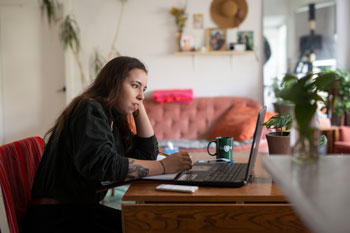
The lives of students, staff and faculty members have been disrupted as they have never been before. Transitioning to learn and work from home has been a stressful and complicated adjustment for everyone, as it has for those essential service employees who have been called to work on campus for the benefit of all of us. Days spent in isolation from fellow students and colleagues for such a long period have affected people’s mental health. Friends and family members have fallen ill from COVID-19; tragically, some have died from it. All around us, signs of the pandemic’s toll have been apparent and have been experienced by every member of our university community, including our 160,000 alumni around the world.
A POST-PANDEMIC WORLD
Thankfully, optimism is building that the world is emerging from the COVID-19 pandemic. More vaccines are being made available, and people in Saskatchewan are now being vaccinated in increasing numbers. Despite current setbacks, a recovered post-pandemic world is now in sight, and I am confident we will see a significantly increased amount of in-person, on-campus instruction and research activity for Fall 2021, and that the fall term will represent a transition to a completely operational university with full face-to-face program delivery at the start of 2022.
My deepest thanks to everyone for their continued patience and responsiveness during these challenging times. And a thank you, as well, to our health-related colleges and units and their many alumni from Medicine, Nursing and so many other health professions who have worked on the front lines throughout the past year. Their exceptional efforts have contributed to controlling the pandemic in crucial ways that continue to prove our value to the province and beyond.
A year into the COVID-19 crisis, while we are closer to the end of this pandemic, we haven’t finished with it—or it with us—quite yet. Flexibility and caution will continue to be required of all of us, as COVID-19 has proven to be unpredictable and to be a planning challenge. Let us all work together to do everything we can to accelerate the end of the pandemic, including continuing to follow all provincial COVID-19 guidelines and getting vaccinated when able to do so. This will ensure we are collectively headed in the direction of being back together again before too long.
A STRATEGIC AND CRITICAL PARTNER
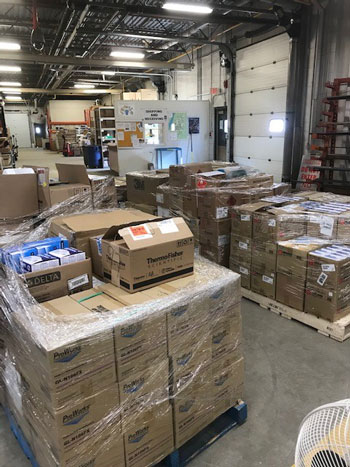
As Saskatchewan's research-intensive medical-doctoral university, we have been a strategic and critical partner in the province’s response and recovery efforts, supporting the health system, finding solutions, and working to help Saskatchewan emerge stronger from the pandemic.
We redistributed PPE supplies from colleges and labs across campus to the Saskatchewan Health Authority (SHA), and decontaminated used N95 masks at VIDO as a backup supply for the SHA. Medicine’s Clinical Learning Resource Centre helped facilitate PPE training for hundreds of Saskatchewan physicians, surgeons, anesthesiologists, and other health care professionals. The College of Dentistry partnered with the Saskatoon Open Door Society to sew 14,000 cloth masks that were distributed to vulnerable populations and essential service workers. Many colleges provided ultra-cold freezers for vaccine storage.
TRANSFORMING MERLIS BELSHER PLACE
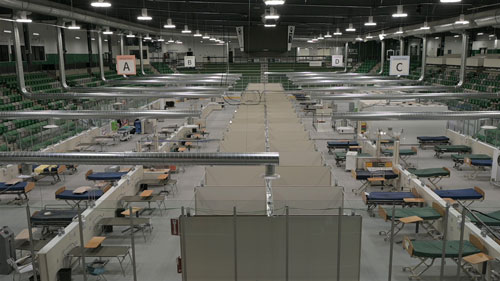
Our Merlis Belsher Place was transformed into a field hospital and now a vaccination centre. Our Canadian Light Source dedicated the synchrotron facility to COVID-19 related research.
Health science students volunteered to field 811 calls and communicate test results, with College of Nursing students and faculty in particular playing key roles in COVID contact tracing. Students from across campus volunteered with the Student-Senior Isolation Prevention Program, providing weekly phone visits. The Continuing Medical Education division provided an online COVID-19 resource centre, and co-ordinated monthly webinars—with more than 1,000 participants from across Canada and beyond—on emerging topics and information about COVID-19.
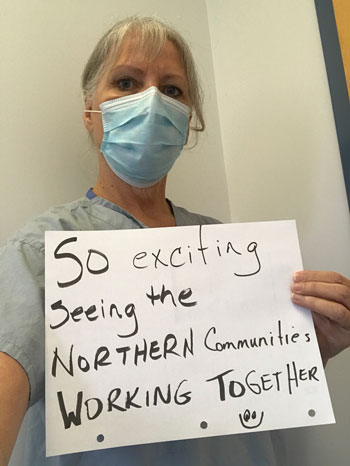
Medical students fundraised for supplies for La Loche when there was an outbreak there; and a health-care team provided prenatal care for pregnant women who were unable to leave La Loche due to the lockdown. Health researchers launched a strategy to inform Indigenous communities about the risks of COVID-19 infection and how to prevent its spread.
We donated 22 structures to the Montréal Lake Cree Nation from our Kenderdine Campus to meet critical housing needs during the pandemic. One hundred and forty-four pharmacy student interns have registered for training to help administer vaccines in response to the new authorized provincial permission for them to help the vaccination rollout. Nursing students partnered with community organizations in Regina on the creation of a community fridge, and led a program to help curb loneliness and isolation among seniors.
ADVISING THE GOVERNMENT
Our many public health experts have advised the provincial government on Saskatchewan’s pandemic response, and have conducted research and media interviews to help inform the public and decision makers. Researchers from our university have been key members of the SHA’s COVID-19 modelling initiative.
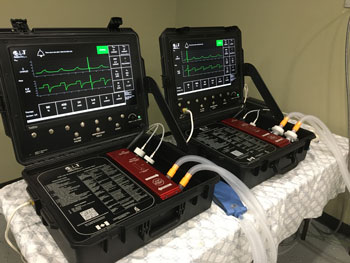
Faculty from medicine, engineering, veterinary medicine, law and business supported local RMD Engineering to design and build ventilators for use in the health system. And faculty from the College of Agriculture and Bioresources worked with industry to manufacture medical-grade hand sanitizer. The College of Dentistry renovated three dental clinics to create isolation rooms for aerosol generating procedures, ensuring continued safe dental care for disadvantaged patients during the pandemic.
A team from the College of Arts and Science history department and the Library launched a community-driven digital archive of life during the pandemic; and researchers with the Community University Institute for Social Research are working with the Saskatoon Poverty Reduction Partnership to identify how access to income and experiences of poverty have shaped individual experiences of the pandemic and impacted population health.
SUPPORTING STUDENTS IN NEED
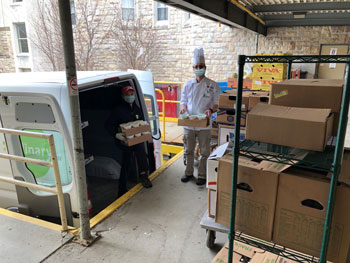
Our Culinary Centre donated food supplies to support local organizations in need, including the Saskatoon Friendship Inn. University employees have allocated more than $500,000 in professional development funds to support our students in financial crisis; our alumni have provided over $300,000 for the same purpose; and our facilities units worked with a local greenhouse last year to sell our unused bedding plants, normally planted each spring across campus, to further support student crisis funding.
Our Johnson Shoyama Graduate School of Public Policy has developed a course examining how Indigenous, municipal, provincial, and national governments have made public policy decisions in response to the pandemic. And faculty in history and in biochemistry, microbiology, and immunology have together created a course on the history of infectious diseases and vaccines.
A tremendous amount of research has been conducted this past year to help ensure effective responses to the pandemic as well. The list is long, a stretches across the university. One example is research by a team from Kinesiology, Pharmacy and Nutrition, and Rehabilitation Science that found face masks do not hinder breathing during exercise. Another involves researchers at the Western College of Veterinary Medicine shedding light on how coronaviruses make the jump from bats to humans and other animals.
PREDICTING COMMUNITY COVID RATES
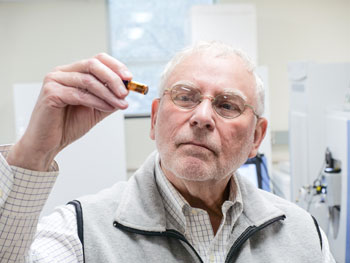
Yet another involves toxicology, water and environmental engineering researchers who have developed a process for predicting community COVID‑19 rates based on wastewater analysis—a week earlier than is otherwise possible by testing the human population.
And our VIDO researchers have been recognized across the country and around the world for being the first in the country to isolate the virus; for developing Canada’s first vaccine candidate, now in clinical trials; for building a pilot manufacturing plant here; and for designing an upgrade to become Canada’s Centre for Pandemic Research. Crucial financial support at the provincial and municipal levels has been committed to this national landmark goal.
These are a few, and by no means the only, examples of how our academic community has played a critical role in addressing the pandemic challenge in this province and beyond. Despite the extreme pressures placed upon all of us this past year, it has proved to be a productive one at our university, full of what would be considered exceptional accomplishments in any year, let alone this one.
We have moved the needle on many aspects of our ambitious University Plan to be The University the World Needs, and a full report on all that success will be forthcoming at Council and elsewhere. But a few—and only a few—highlights include the fact that, while successfully dealing with the pandemic, we are educating more students this year than we ever have in our history, and that extraordinary research has been undertaken that will positively affect the lives of many.
Many assumptions were made at the beginning of the pandemic about its likely negative effects on the province, the world, and this university. And although the year has been a difficult one for so many, much was achieved here.
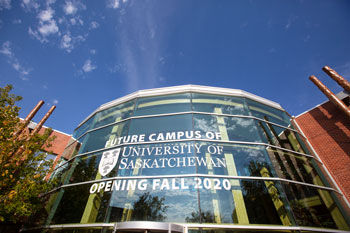
We held a virtual opening of our new Prince Albert Campus last fall and look forward to a full in-person celebration of this milestone in the university’s history when it is possible to have one. Our university has a long history of being present in the north—running academic programs and conducting research with communities, particularly in Nursing and in other disciplines as well.
DEVELOPING A NORTHERN STRATEGY
The new campus, along with the development of a northern strategy, reaffirms our commitment to Indigenous and northern education. That commitment will be spotlighted this spring when we celebrate the first graduates from our Nunavut Law Program that we initiated four years ago.
Meanwhile, our Nursing program continues to be a made-in-Saskatchewan success story, with more than 20 per cent of our undergraduate nursing students self-identifying as Indigenous—the highest proportion of any university in Canada—with a remarkable retention rate of 90 per cent. We also established an Indigenous Research Chair in Nursing, the first of its kind for USask.
We signed an MOU with the Meewasin Valley Authority that strengthens our long-standing relationship and co-ordinates our respective efforts to help sustain our precious and unique urban river valley environment. Our fine arts faculty and students, at times with students from across the university, produced on-line choral, band and theatre performances of extraordinary creativity.
University of Saskatchewan health researchers have been awarded $5 million by the Canadian Institutes of Health Research (CIHR) to a lead a network of Indigenous research centres as part of a major new national initiative. And three of our national research facilities—the Canadian Light Source, SuperDARN, and VIDO—were awarded a full one-third of the Canada Foundation for Innovation’s Major Science Initiatives (MSI) funding. No other university in Canada came anywhere close to this level of MSI funding.
FIRST IN WATER RESEARCH
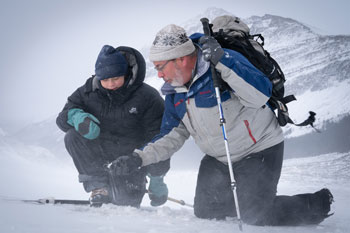
In Canada’s Top 50 Research Universities 2020 rankings, the University of Saskatchewan is ranked first among the country’s medical universities for growth in total research income—an almost 40-per-cent gain in all external research grants and contracts. Five of our faculty members were honoured by the Royal Society of Canada this past year—four of them women. According to the recently published 2020 Academic Ranking of World Universities, we are ranked first in Canada and 20th in the world for water resources research. We also placed in the top 100 universities in the world in several other research areas.
Our Crop Development Centre celebrated its 50th anniversary this year. During that half-century it has released more than 500 new crop varieties—an average of 100 for each decade—and in so doing has been instrumental in making this province a world agriculture leader in exporting crops such as peas, lentils and chickpeas. It has also led global science breakthroughs, including cracking the wheat genetic code.
As part of our impressive agriculture contributions, the Global Institute for Food Security—in its 10th anniversary year—has launched the Omics and Precision Agriculture Laboratory that will speed up innovation of new products and services to enhance profitability and sustainability across the agriculture and food sectors.
MILESTONE MOMENTS
As I mark anniversary milestones, I want to mention as well that 2021 is the 50-year anniversary of our former faculty member Gerhard Herzberg receiving the Nobel Prize for Chemistry—and a powerful reminder of the importance of the excellent fundamental research that this university has carried out for more than a century.
Our research initiatives are now being led by our new Vice-President of Research, Dr. Baljit Singh, who joined our new Provost and Vice-President Academic, Dr. Airini, in re-invigorating our diverse and dedicated senior leadership team. And each, by the way, has been recognized with one of the two highest awards in teaching excellence in the country—the 3M Fellowship and the Alan Blizzard Award respectively.
Honorary Degree recipient and Gordon Oakes Red Bear Student Centre advisor and Elder Louise Halfe-Sky Dancer was named this year as Canada’s ninth Parliamentary Poet Laureate, whose duties include “promoting the importance of literature, culture and language in Canadian society.” Our Library has introduced the Indigenous Storyteller-in-Residence program, led by Lindsay Knight-Ekwol.
In June, I released an institutional statement on racism. As I acknowledged in it, racism and discrimination are experienced by members of the USask community. I stated that it is our collective responsibility to build and shape the community and the world we want every day. Universities such as ours, benefiting from the diversity of perspectives of thousands of students, faculty, staff and alumni, can positively influence behaviour and understanding in ways no other kinds of institutions can. If we are deliberate and courageous, we can make these changes together through dialogue, education and action.
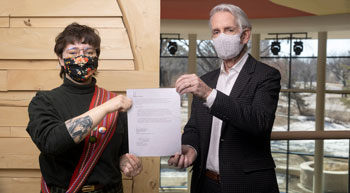
A key action for guiding our continuing efforts to dismantle racism and discrimination is the Equity, Diversity and Inclusion Policy that was approved by our three governing bodies this year. It states that “All members of the university community share the responsibility for creating a supportive and inclusive environment.”
Another is the MOU signed by my office and the University of Saskatchewan Students Union to create an inclusive, equitable and safe learning environment here. Yet another is the appointment of Dr. Verna St. Denis as the first special advisor to the president on anti-racism and anti-oppression.
FIRST SUSTAINABILITY STRATEGY

Our Council and Board have recently adopted the university’s first Sustainability Strategy that commits us to action on the UN’s 17 Sustainable Development Goals. Sustainability isn’t merely another problem to be tackled or solved. It needs to pervade all decisions at our institution. With only 10 years remaining before the United Nations’ 2030 deadline, we need to be unapologetically ambitious and appropriately impatient in our actions on sustainability.
The 2020 Times Higher Education rankings on university performance against the UN SDGs placed us in the top 100 out of 766 participating universities globally, with very strong performances in four of the SDGs including “Zero Hunger”, “Good Health and Wellbeing”, “Clean Water and Sanitation”, and “Peace, Justice and Strong Institutions.” These directly align with our signature areas in food, one health, and water, and are worth celebrating while we continue to aim higher.
Each of these plans—on EDI and on Sustainability—represents a momentous step in our university’s progress to being the university the world needs. Any of these accomplishments would be notable in an average year—they are even more notable for having been achieved during the pandemic. They continue to show how we are responding to the world’s needs. But how will we be the university a post-pandemic world needs?
The world’s recovery, and the opportunity it presents, lie before us. The pandemic has revealed deep flaws in our society but at the same time has opened the door to a better one—more equitable, less divided, built on confidence in ourselves and each other. To take advantage of that opened door we must be deliberate about what we have learned as we build back for the future. And one thing we’ve learned is that, together, we can confidently make unpredicted and deep changes in a short amount of time, as we did when we moved an entire university on-line a year ago in the space of five days, and continued that through to today. Motivated by that spirit, we are well into our Post-Pandemic Shift Project’s work.
POST-PANDEMIC SHIFT PROJECT
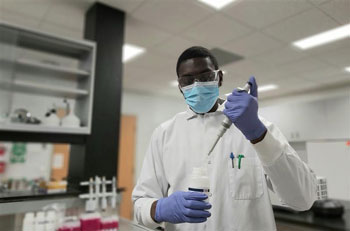
That project has engaged with many external groups and has heard that the world will be re-evaluating how people work together, lead each other, and make decisions. How people create together, learn together, and care for each other. How they help each other heal. Much other work being done globally on the nature of a post-pandemic world confirms these findings. It remains for us to decide how we will respond to these needs. Resisting creative change is not an option for us—as I’ve said in previous GAA remarks, if we don’t like change, we’ll like irrelevance even less. The world around us will not be the same as before, and because we must be responsive to that, neither will we.
What should our changes look like? I encourage you to contribute to the discussions being organized by the Post-Pandemic Shift Project to express your thoughts. We know we can reach many students, in the province’s northern communities and elsewhere through on-line programming, who would otherwise not have the opportunity to come to our campuses or to attend university at all. How can we step up for them in this regard? We know that with our many colleges and schools, and with our university community talent and what it accomplished this past year, we can do the kind of research a post-pandemic world needs.
What should that look like? We know that our in-person workplace can become more flexible in the future. What sorts of changes do we want to see there? We know that many people in this country and beyond have lost their jobs, or have had their jobs change, requiring us to provide the means for them to adjust to a new workforce or to re-enter it. How will we provide what they need? Micro-credentialing, upskilling, and streamlining our academic approvals systems will be crucial here.
EMERGE UNITED, DELIBERATE AND CREATIVE

Encouraged by our USask community’s confident and positive response to the pandemic one year after it began, I have reason to believe we will emerge united, deliberate and creative in our commitment to being the university the post-pandemic world will need. The province, in its multi-year commitment to us in the budget of two days ago, continues to value our contributions to Saskatchewan and the world.
Like all universities in Canada, our financial challenges are not insignificant. Please make no mistake; these challenges—faced by every university in this country—will require us to make changes to what we do. But we have an excellent roadmap in our University Plan 2025, and we have shown we can make changes that are driven by our academic mission. A post-pandemic world gives us the opportunity, and the imperative, to make those changes.
COVID-19 is not over, but I am thankful we are now beginning to see beyond the difficulties and challenges of this past year, and that a better time awaits us on the horizon. And I thank all members of the USask community for upholding the vision, mission, and values of this great university over this past intensely challenging year.

